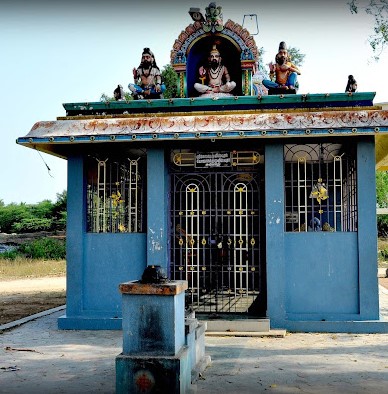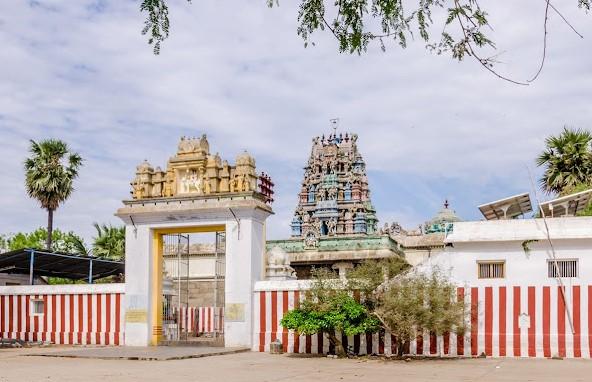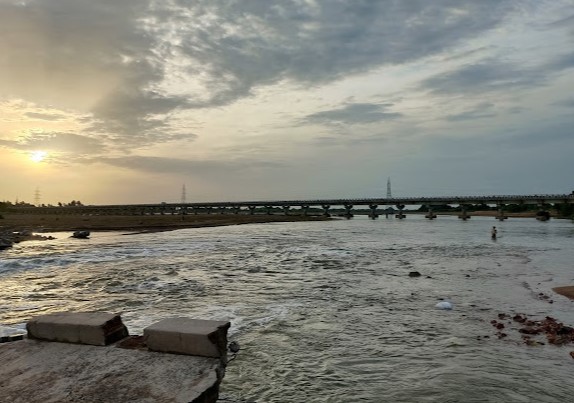History and Name of the Place
The ancient place was abundant with palm (Panai) trees, leading to the name Panangkattur, and the presiding deity is called Sri Panangkatteeswarar.
The place is now known as Thirupanangadu.
Renovation by Sri A. Ekappa Chettiar
The temple was renovated and constructed by Devakottai Sri A. Ekappa Chettiar’s family, as mentioned in stone inscriptions in the temple.
The Mahakumbabishekam (consecration ceremony) was performed by the family in 1928.
Ekappa Chettiar's Motivation:
In 1915, Sri Ekappa Chettiar was involved in a property litigation case.
He prayed to Lord Shiva for help and, upon browsing the Devaram, selected the pathigam (hymn) associated with this temple.
He vowed to do something for the temple if he won the case.
After winning the case, he visited the temple and discovered it in ruins. He used his settlement money to renovate the temple.
A statue of Sri Ekappa Chettiar can be found in the main hall of the temple, commemorating his contributions.
Legend of Sage Agasthya
During his travels in the south, Sage Agasthya desired to worship Lord Shiva at this site. The following events are associated with his visit:
The Lord conveyed through a divine voice that He was present as a Swayambu Linga under a neem tree.
Agasthya discovered the Linga near a meditating sage, who pointed out the deity before resuming meditation.
The Sage’s Challenges and Lord Shiva’s Blessings
Water for Puja:
Agasthya lacked water for puja.
Lord Shiva poured Ganga water from His head, creating the Jada Ganga Theertham (holy spring originating from the Lord’s tuft).
Fruits for Nivedhana:
When Agasthya needed fruits for offering, Lord Shiva dropped palm fruits for him.
This led to the Lord being called Thalapureeswarar (Thalam meaning palm tree).
Divine Darshan:
Pleased with Sage Agasthya’s devotion, Lord Shiva granted him darshan.
PURANIC SIGNIFICANCE:
Legend of Sundarar and Lord Shiva
When Saint Sundaramurthy Nayanar visited the area, Lord Shiva appeared before him in the guise of an old man, offering food (Kattamudu). Doubting the significance of the food in a place lacking water, Sundarar laughed. The old man scratched the ground, causing water to flow miraculously. Realizing the old man was Lord Shiva, Sundarar followed the footprints of a bull and discovered the temple. Lord Shiva and Goddess Parvathi blessed Sundarar with their divine vision (dharisanam). Sundarar referred to this place as “Vanparthan Panangkattur” in his hymns.
Sundarar Theertham
The well, believed to have been created by Lord Shiva, is called “Sundarar Theertham.” Located about a kilometer from the temple, the well is fenced and well-maintained. Nearby, a shrine marks the spot where Sundarar consumed the food offered by Lord Shiva. Despite its shallow depth of 3 feet, Sundarar Theertham contrasts sharply with neighboring wells that are 30 feet deep.
Shrines Installed by Sages Agasthiyar and Pulasthiyar
The temple features two shrines for Lord Shiva:
Sri Thalapureeswarar (Sri Panangkatteswarar): Installed by Sage Agasthiyar, accompanied by Goddess Amirthavalli.
Sri Krupanatheswarar: Installed by Sage Pulasthiyar, accompanied by Goddess Krupanayaki.
Agasthiyar and Kottai Muniswarar
Sage Agasthiyar sought a temple and found Sage Kottai Muniswarar meditating under a neem tree. Upon learning of a Shivalingam beneath the tree, Agasthiyar unearthed and installed it in a shrine. Lord Shiva blessed Agasthiyar, and the name “Thalapureeswarar” arose after palm fruits fell onto the lingam during worship. Agasthiyar later entrusted Kottai Muniswarar with the temple’s care.
Pulasthiyar’s Contribution
Sage Pulasthiyar installed another Shivalingam on the banks of the Palar River. This lingam was later discovered by a Chola king and moved to the temple, where it was installed alongside the lingam worshipped by Sage Agasthiyar.
Panangkattu Thambiran and Jada Gangai Theertham
A devotee, Panangkattu Thambiran, prayed for drinking water for the local population. Lord Shiva caused water to flow from his head, and this was stored in a nearby tank called “Jada Gangai Theertham,” which remains in use today.
Worship by Other Divine Beings
The temple has been sanctified by the worship of several divine beings, including:
- Lord Brahma
- Lord Mahavishnu
- Lord Indiran
- Sage Kannuva
Additional Features

A small temple for Sri Kottai Muneeswarar is located in front of the main temple.
The legends and sacred theerthams underline the temple's spiritual and historical significance.
ADMINISTRATION:
The temple is under the administration of the Hindu Religious and Charitable Endowments Department (HR&CE), Tamil Nadu. It is a state-managed temple.

